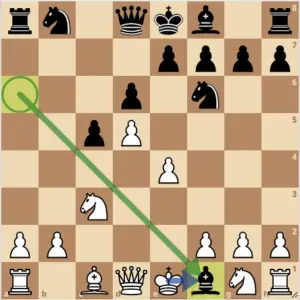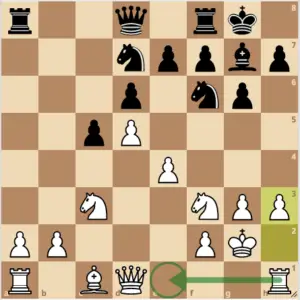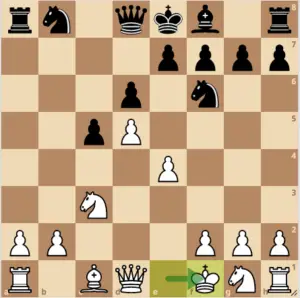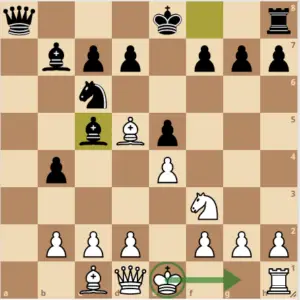Castling is a very effective move that helps to safeguard your king and develop your rook. Without castling, your king would be in grave danger as it would be stuck in the center of the board.
Sometimes, your king is forced to move to an undesired square due to threats and attacks from the opposing side. This begs the question, Can you castle after moving your king? Here is what you should know.
Can You Castle After Moving Your King?
According to the rules of chess, you cannot castle on the kingside nor the queenside after moving your king. However, you can choose to castle artificially if you have lost castling rights. This is a sequence of moves done with the king and rook in order to get your king to a safe square as if it was castled in the first place.
One famous example is in the Benko Gambit. White has just moved his king to recapature the bishop on f1, thereby giving up castling rights. White can castle artificially by moving his king over to the g2 square and shifting his rook to the e-file. It’s as if nothing has happened.
White moves his king and loses castling rights

White castles artificially via Nf3-g3-kg2

The draw back to artificial castling compared to normal castling is that you lose valuable time. With regular castling you can move two pieces in one move which saves you a lot of time. But with artificial castling, you could potentially waste up to 4 moves.
If your king has been moved in the game, then your best choice to secure the safety of your king is to castle artificially. However, this move is not that easy to achieve. There are certain guidelines you need to know in order to safely execute an artificial castle. These include:
1. The center must be static
The center must be static or closed off. An open center will cause your king to be stuck in it’s position, which makes it really hard to castle artificially.
To secure a static center, it’s best to use your pawns to close up the position. When this happens, it’s harder for your opponent to break through the position and open lines for his bishops. Bishops can be a knightmare for the king as they can block the path for the king to castle and deliver nasty checks. This brings us to our next guideline…
2. Control the Activity Of Your Opponent’s Bishop
Since we know the bishop to be a dangerous piece, it’s best to trade it off with another piece or restrict it’s activity in order to prevent it from attacking the uncastled king. You can restrict the movement of this piece by closing down the center with your pawns.
3. Secure The Escape Route
In order to sucessfully castle artificially, you need to secure an escape route for your king. This often means fianchettoing the king, which is to play g3 or g6 then moving your king to g2 or g7. Squares like g2 or g7 will act as a shelter for the king and it also makes way for the rook in the corner to develop.
If you are playing white, you must be aware of the light squares because that is that path to which the king is going to castle artificially. Make sure that your opponent’s light squared bishop won’t interfere with this sequence of moves and that it won’t attack the king. Once again, it’s best to trade off your opponent’s light squared bishop in order to secure the escape route.
Now, let’s look at some games in which artificial castling was performed successfully:
1. Benko Gambit Artificial Castle
The common line in the Benko Gambit features the artificial castling manouvre. It begins with the moves: 1.d4 Nf6 2.c4 c5 3.d5 b5 4.cxb5 a6 5.bxa6 Bxa6 6.Nc3 d6 7.e4 Bxf1 8.Kxf1

White can safely proceed to castle artificially since the center is static. There is a closed pawn center which means Black cannot open up the position. Black already traded off his light squared bishop on f1, so it is much easier and safer for white to castle artificially on the light squares as it won’t be attacked. White should have a good game with a pawn up!
Artificial castling proceeds with: 8…g6 9.Nf3 Bg7 10.g3 0-0 11.Kg2 Nbd7 12.h3 (White will later swing his h1 rook over to the e-file to complete castling with future ideas of e5)
2. Artificial Castling After Bishop Sacrifice
One of the most common positions where artificial castling takes place is in the Four Knights Italian Variation where black temporarily sacrifices a knight in order to gain some level of equality. It starts with the moves:
1.e4 e5 2.Nf3 Nc6 3.Bc4 Nf6 4.Nc3 Nxe4!

A common reply, but bad move, is to sacrifice the bishop on f7 forcing the king to move and give up castling rights. But after 5.Bxf7+ Kxf7 Black is doing just fine.
White gave up the light squared bishop which makes it harder to hassle the black king and prevent it from castling artificially. There is a clear escape route for the Black king as it is very difficult for white to attack black on the light squares. Black can also use his own light squared bishop to control these squares.
The game continues: 6.Nxe4 Be7 7.0-0 Rf8 8.d4 exd4 9.Nxd4 Kg8 and Black has managed to castle artificially after have losing castling rights. Black could have also played the early 6…d5 grabbing control of the center (This appears to be the best move).
Nevertheless, Black has secured the king and will play d5 on the next move with a comfortable position.
How To Secure Castling Rights?
Castling is a very important move in chess as it safeguards your king and helps to develop your rook in the game.
For this reason, players should always strive to preserve the right to castle, and that means to avoid moving the king. There are 2 precautionary measures you can take to secure castling rights. These include:
1. Prioritize Kingside Development
The main reason why players lose the right to castle is because they disregard their kingside development. When your knight and bishop are stilll on their initial position, it is easy for the opposing side to attack your king and force it to move.
And, when your king moves, you can no longer castle and bring it to safety. Therefore, your opponent can crush your king in the center.
To avoid this, you need to prioritize developing your king’s knight and bishop first before any other piece, especially if you are a beginner player. Beginners need to castle as early as possible so that their king is away from the threats of the opposing side.
Once you’ve castled, then you can focus your attention on other aspects of the game such as launching an attack or setting up a strategic plan for your pieces.
2. Watch Out For Checks
The main reason why beginner players are forced to move their king is because they don’t take the time to look for their opponents threats.
A check is a move that will force the king to react either by blocking the attack, capturing the piece delivering check, or moving the king out of the way. When you move the king out of the way of check, you no longer can castle and that means you could have a miserable game the entire match.
So as a precautionary measure, always look out for checks from your opponent!
Can You Castle After Moving Your Rook?
The rule states that you cannot castle on the side where the rook was moved. So the answer is no. This means that if you moved your h1 rook as white, then you cannot castle kingside. However, you can castle queenside given that the a1 rook and king did not move at all in the game.
Similarly, white can castle kingside given that his king and h1 rook had not been moved in the game, even if the h1 rook had been moved. For example, in this position, white can castle kingside even though white’s a1 rook has been gone off the board.

Final Verdict
Since the game makes it illegal to castle after moving your king or rook, it’s important that we prevent this from happening.
Prioritizing kingside development is the best way to prevent you from losing castling rights. However, if it so happens that your king moved in the game and you can no longer castle, then you should find a way to artificially castle your king.
Just remember to keep the center static or closed and watch out for your opponent’s bishop or else your king could get smashed in the center of the board.


